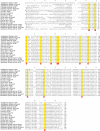Selective Interaction of Sugarcane eIF4E with VPgs from Sugarcane Mosaic Pathogens
- PMID: 33809985
- PMCID: PMC8005120
- DOI: 10.3390/v13030518
Selective Interaction of Sugarcane eIF4E with VPgs from Sugarcane Mosaic Pathogens
Abstract
Eukaryotic translation initiation factor 4E (eIF4E) plays a key role in the infection of potyviruses in susceptible plants by interacting with viral genome-linked protein (VPg). Sugarcane (Saccharum spp.) production is threatened by mosaic disease caused by Sugarcane mosaic virus (SCMV), Sorghum mosaic virus (SrMV), and Sugarcane streak mosaic virus (SCSMV). In this study, two eIF4Es and their isoform eIF(iso)4E and 4E-binding protein coding genes were cloned from sugarcane cultivar ROC22 and designated SceIF4Ea, SceIF4Eb, SceIF(iso)4E, and ScnCBP, respectively. Real-time quantitative PCR analysis showed different expression profiles of these four genes upon SCMV challenge. A subcellular localization assay showed that SceIF4Ea, SceIF4Eb, SceIF(iso)4E, and ScnCBP were distributed in the nucleus and cytoplasm. Yeast two-hybrid (Y2H) and bimolecular fluorescence complementation (BiFC) assays showed that SceIF4Ea/b and SceIF(iso)4E were selectively employed by different sugarcane mosaic pathogens, i.e., SCMV-VPg interacted with SceIF4Ea/b and SceIF(iso)4E, SrMV-VPg interacted with both SceIF4Eb and SceIF(iso)4E, and SCSMV-VPg interacted only with SceIF(iso)4E. Intriguingly, the BiFC assays, but not the Y2H assays, showed that ScnCBP interacted with the VPgs of SCMV, SrMV, and SCSMV. Competitive interaction assays showed that SCMV-VPg, SrMV-VPg, and SCMV-VPg did not compete with each other to interact with SceIF(iso)4E, and SceIF(iso)4E competed with SceIF4Eb to interact with SrMV-VPg but not SCMV-VPg. This study sheds light on the molecular mechanism of sugarcane mosaic pathogen infection of sugarcane plants and benefits sugarcane breeding against the sugarcane mosaic disease.
Keywords: SCMV; SCSMV; SrMV; VPg; eIF4E.
Conflict of interest statement
The authors declare no conflict of interest. The funders had no role in the design of the study; in the collection, analyses, or interpretation of data; in the writing of the manuscript, or in the decision to publish the results.
Figures







Similar articles
-
Variability in eukaryotic initiation factor iso4E in Brassica rapa influences interactions with the viral protein linked to the genome of Turnip mosaic virus.Sci Rep. 2018 Sep 11;8(1):13588. doi: 10.1038/s41598-018-31739-1. Sci Rep. 2018. PMID: 30206242 Free PMC article.
-
Sugarcane Elongin C is involved in infection by sugarcane mosaic disease pathogens.Biochem Biophys Res Commun. 2015 Oct 23;466(3):312-8. doi: 10.1016/j.bbrc.2015.09.015. Epub 2015 Sep 8. Biochem Biophys Res Commun. 2015. PMID: 26362180
-
Helper component proteinase of the genus Potyvirus is an interaction partner of translation initiation factors eIF(iso)4E and eIF4E and contains a 4E binding motif.J Virol. 2011 Jul;85(13):6784-94. doi: 10.1128/JVI.00485-11. Epub 2011 Apr 27. J Virol. 2011. PMID: 21525344 Free PMC article.
-
Historical Review of Sugarcane Streak Mosaic Virus that Has Recently Emerged in Africa.Phytopathology. 2024 Apr;114(4):668-680. doi: 10.1094/PHYTO-08-23-0291-RVW. Epub 2024 Apr 22. Phytopathology. 2024. PMID: 37966994 Review.
-
Present status of the sugarcane mosaic subgroup of potyviruses.Arch Virol Suppl. 1992;5:363-73. doi: 10.1007/978-3-7091-6920-9_39. Arch Virol Suppl. 1992. PMID: 1450763 Review.
Cited by
-
Ryegrass mottle virus complete genome determination and development of infectious cDNA by combining two methods- 3' RACE and RNA-Seq.PLoS One. 2023 Dec 5;18(12):e0287278. doi: 10.1371/journal.pone.0287278. eCollection 2023. PLoS One. 2023. PMID: 38051715 Free PMC article.
-
Fighting Death for Living: Recent Advances in Molecular and Genetic Mechanisms Underlying Maize Lethal Necrosis Disease Resistance.Viruses. 2022 Dec 12;14(12):2765. doi: 10.3390/v14122765. Viruses. 2022. PMID: 36560769 Free PMC article. Review.
-
Identification and characterization of the Remorin gene family in Saccharum and the involvement of ScREM1.5e-1/-2 in SCMV infection on sugarcane.Front Plant Sci. 2024 Feb 23;15:1365995. doi: 10.3389/fpls.2024.1365995. eCollection 2024. Front Plant Sci. 2024. PMID: 38463560 Free PMC article.
-
Interaction Between Translation Initiation Factor eIF4E in Banana and the VPg Protein of Banana Bract Mosaic Virus Reveals Potential Targets for Genome Editing.Mol Biotechnol. 2024 Dec 23. doi: 10.1007/s12033-024-01337-w. Online ahead of print. Mol Biotechnol. 2024. PMID: 39715933
-
Susceptibility factor StEXA1 interacts with StnCBP to facilitate potato virus Y accumulation through the stress granule-dependent RNA regulatory pathway in potato.Hortic Res. 2022 Feb 13;9:uhac159. doi: 10.1093/hr/uhac159. eCollection 2022. Hortic Res. 2022. PMID: 36204208 Free PMC article.
References
-
- Rae A., Jackson M., Nguyen C.H., Bonnett G.D. Functional Specialization of Vacuoles in Sugarcane Leaf and Stem. Trop. Plant Biol. 2008;2:13–22. doi: 10.1007/s12042-008-9019-9. - DOI
-
- Lam E., Shine J., Da Silva J., Lawton M., Bonos S., Calvino M., Carrer H., Silva-Filho M.C., Glynn N., Helsel Z., et al. Improving sugarcane for biofuel: Engineering for an even better feedstock. GCB Bioenergy. 2009;1:251–255. doi: 10.1111/j.1757-1707.2009.01016.x. - DOI
-
- Sabatier D., Martiné J., Chiroleu F., Roussel C., Letourmy P., Antwerpen R.V., Gabrielle B., Ney B. Optimization of sugarcane farming as a multipurpose crop for energy and food production. GCB Bioenergy. 2015:7. doi: 10.1111/gcbb.12133. - DOI
-
- Wu L.J., Zu X.F., Wang S.X., Chen Y.H. Sugarcane mosaic virus—Long history but still a threat to industry. Crop Prot. 2012;42:74–78. doi: 10.1016/j.cropro.2012.07.005. - DOI
-
- Zambrano A.Y., Demey J.R., Fuchs M., Gonzalez V., Rea R., De Sousa O., Gutierrez Z. Selection of sugarcane plants resistant to SCMV. Plant Sci. 2003;165:221–225. doi: 10.1016/S0168-9452(03)00162-6. - DOI
Publication types
MeSH terms
Substances
Supplementary concepts
LinkOut - more resources
Full Text Sources
Other Literature Sources
Miscellaneous

